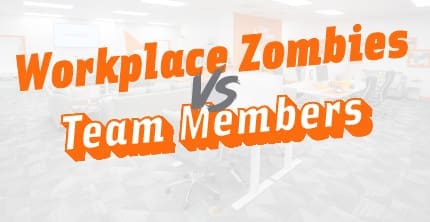 You’re trapped inside a large, featureless office building.
You’re trapped inside a large, featureless office building.
You’re supposed to gather supplies and prepare them for transportation back to camp. But horrible scratching and thumping noises make it difficult for you to complete your task. The zombies are outside, trying desperately to find a way in. They know you’re in the building, and they’re starving for a taste of your brain.
This scenario is precisely how team members with anxiety, depression, PTSD, schizophrenia, and even eating disorders can feel while working unless their employer considers their mental health needs. In fact, mental health is something that should be considered for every team member… regardless of a diagnosis.
What can a business do to create a more inclusive, nurturing, and understanding work environment for team members with these mental health challenges? In other words, how can an employer protect their team members from getting bitten by clamoring, clawing zombies?
A Guide to Workplace Zombies:
Unlike real zombies (or should I say, “the fictional impression of a zombie”), workplace zombies are not as easily identified. They aren’t covered in mold and dried blood. In fact, they don’t even have bodies. They’re more dangerous than that; they exist as worrisome concepts, scary ideas, or warped perceptions of reality that can’t be held at bay with walls or soldiers.
These can be exacerbated by the real-world challenges in the workplace of tight deadlines, understaffing, inflexible hours, harassment or bullying, lack of co-worker support, isolation, a negative workplace culture, poor work/life balance, and more.
Some businesses can be filled with uncertainty, negativity, and stress. In such an environment, workers can be endlessly distracted by the scratching and thumping of hungry zombies.
Hold the Workplace Zombies at Bay
The zombies are here. And for those with mental health issues (and we all have our mental health battles to fight), these nagging zombies will even follow them home after work. But what can an employer do to increase their team members’ comfort and productivity levels at work?
In her Harvard Business Review article, Katherine Ponte suggests that employers/supervisors prepare themselves by learning everything they can about how different psychological disorders can affect a person at their job. Then, watch for signs of a team member struggling.
Once spotted, a manager should choose a good time to approach that team member, start a conversation using supportive language, and explore ways of alleviating that person’s stressors.
Some team members may need a chance to go for a brief walk a few times each day or work outside for a while. They may need support from a co-worker or just need to talk to someone. Others may be stressed about bills and be best served by an advance on their pay.
Clarissa Windham-Bradstock suggests in her Forbes article that companies create a mental health strategy to better combat the mental health zombies:
- Invest in making sure team members feel safe, valued, and heard.
- Educate all team members on working alongside and including those with mental health issues.
- Create tools for team members to balance their work and home life better.
As with all other facets of business, communication is critical. The worst thing an employer can do about mental health problems at the workplace is nothing. When mental health disorders like depression, anxiety, PTSD, and others aren’t discussed, they remain taboo topics that team members will feel embarrassed to talk about with anyone. They will have to fight the zombies with no backup.
Rock Paper Simple’s Thoughts on Mental Health
We believe that mental health is relevant for everyone and that we often neglect our mental health in ways we never would for our physical health. Taking care of our minds somehow always seems like a second thought or less important than anything taking place at the moment.
We feel so strongly about this. Rock Paper Simple and Mendx Studios (our sister studio) created a documentary in partnership with some awesome investors called Breakthrough: A Mental Health Journey, which tells the stories of a diverse group of people and their own mental health journeys. Its purpose is to destigmatize mental health and show that we all have our own mental health battles… we believe it will help bring positive change to how Americans view mental health.
So how does an employer invest in the mental health of their team members? We don’t claim to be the experts in this area, but we have a Purpose Statement here that is simply, “Because People Matter” and is a great place to start. Determining that people are our focus means we must always understand how what we do affects the people we work with and work for.
Here are just some things we emphasize and do to invest in our team’s mental health:
- Work Life Balance – We won’t always claim to win the battle against the zombies in this category, but we work very hard to protect our team’s work life balance as much as we can. This starts by simply committing to the fact that it is important to your organization’s culture… from there, it will look different for every organization.
- One practical way we do this is to monitor bandwidth and ask our team members each week to report on their scorecards on a scale in terms of workload and how much time they are working extra each week. This allows our team leaders to identify if someone is consistently putting in extra time and come alongside them to find out why to determine what can be done. It’s terrible for a team member to get burned out because their team didn’t know they were burning the midnight oil.
- Another option is to give opportunities for team members to put in extra hours to earn additional PTO or other incentives. We have recently been experimenting with methods to implement this. As a small business, we know it can be challenging to balance taking care of your people and keeping the numbers out of the red, but it can be done!
- Chaplains – One really impactful thing we do is engage with Marketplace Chaplains, which assigns a diverse team of chaplains to each company. They are nationwide and affordable. These chaplains make regular weekly office visits and are always (24/7) available to team members who need someone to talk to about anything from mental health issues to spiritual struggles. While faith-based, they never overstep, and the well-being and privacy of each team member come first for them.
- While everything they speak about is confidential, they report each quarter regarding how many private conversations were had (not with who) and the high-level topics. They often include family, health, faith, parenting, marriage, and sometimes really hard conversations such as death and conflict.
- Chaplains can be a huge backup in the fight against the zombies, but there are other options, too… some organizations provide prepaid mental health therapy sessions you can provide to your team as a benefit.
- A Safe Work Space – We have heard how influential a good culture is for so many reasons, but none is quite as crucial as a safe place where voices are heard, and there is trust between team members, leaders, and all involved in the organization. If your team can’t trust those they report to, dig deeper and find out why. We operate on an EOS system that provides a framework for clear accountability, vision, goals, responsibilities, and methods to bring issues to the surface.
- Learn Together – We recently began reading the book, The Five Dysfunctions of a Team to dig more into how we can better operate as one unit and respectfully handle conflict in a way that makes us all better. This makes for a healthier team, and a healthier team can beat back those zombies of mental health oppression more effectively.
- Some other tools in our toolbelt include Redirect Healthcare‘s free virtual mental health counseling, an emphasis on healthy conflict, benefits like every other Friday on-call, and a limited set of monthly work-from-home days.
This is by no means meant to be an exhaustive list of ways you can invest in your team’s mental health, but are some ways we do it here. Sharing these might inspire others to invest further in their teams. Let’s fight back against that zombie apocalypse and make our workplaces better for the people there!

